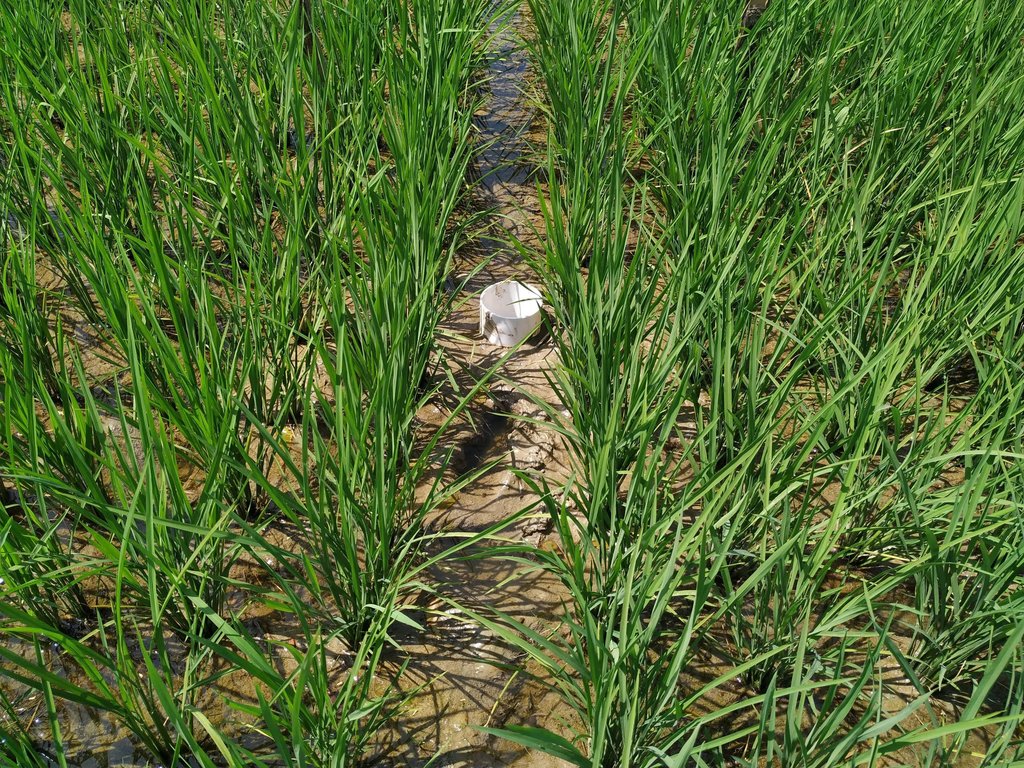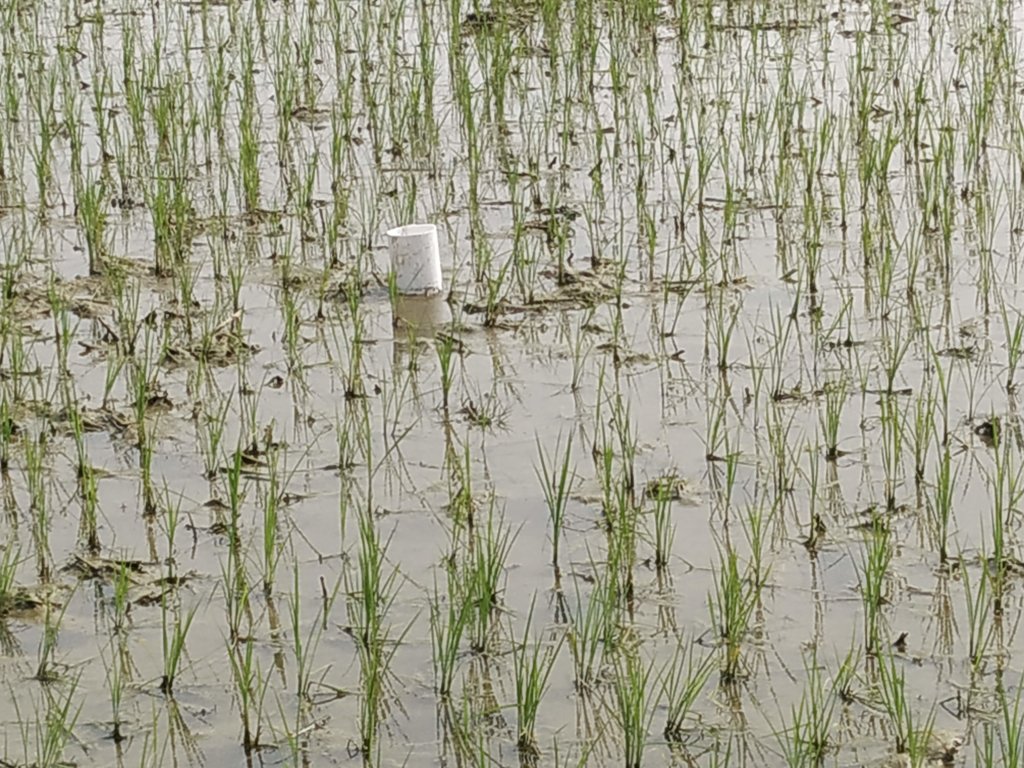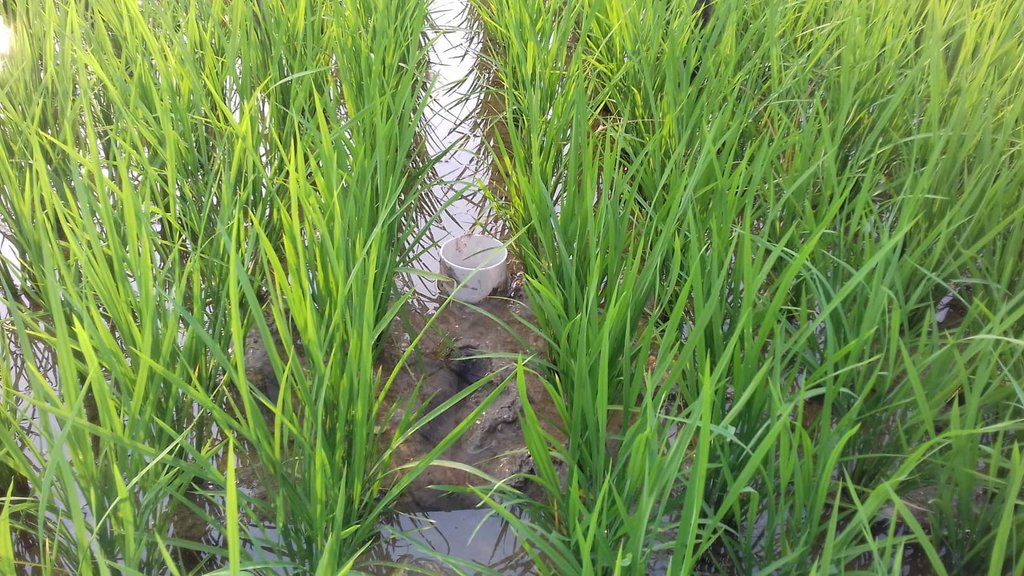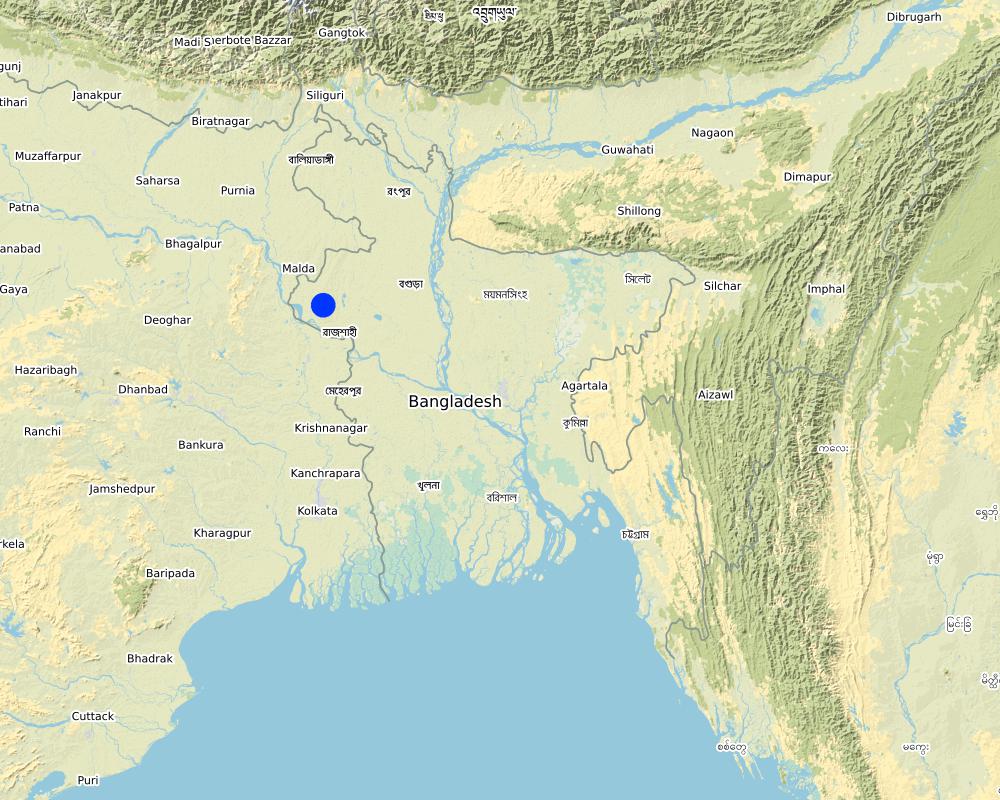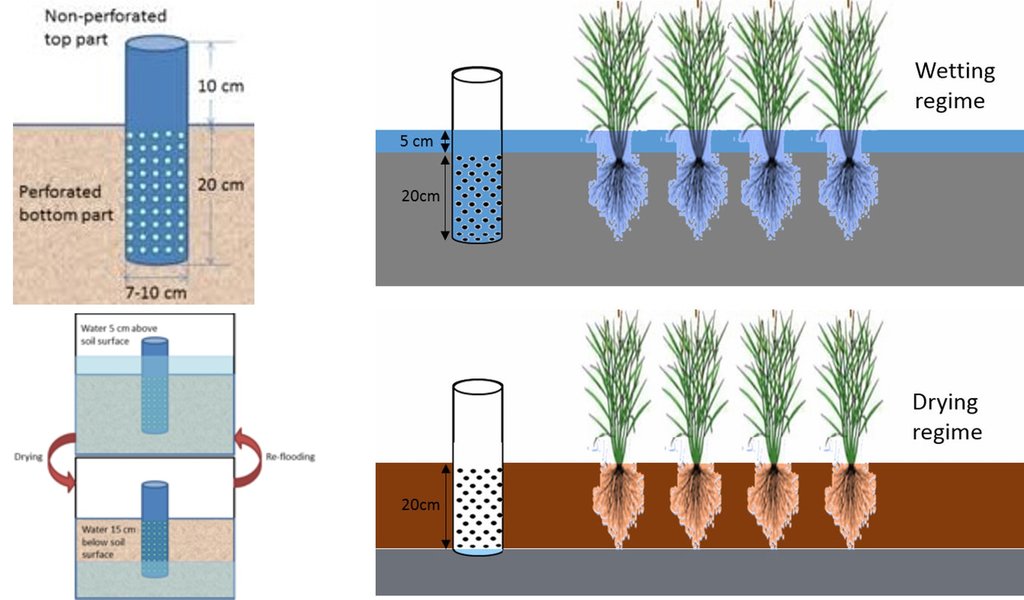Alternate wetting and drying (AWD) method in rice cultivation [Bangladesh]
- Creation:
- Update:
- Compiler: Mutasim Billah
- Editors: Md. Monzurul Haque, Matieu Henry
- Reviewers: Nicole Harari, Rima Mekdaschi Studer, Ursula Gaemperli
Magic pipe er madhomme kom panite dhan chas
technologies_4671 - Bangladesh
View sections
Expand all Collapse all1. General information
1.2 Contact details of resource persons and institutions involved in the assessment and documentation of the Technology
land user:
Zaman Md. Shahid Uz
Farmer
Bangladesh
co-compiler:
Azad Md. Abul Kalam
Department of Agricultural Extension (DAE)
Bangladesh
co-compiler:
Jalal Uddin Dewan
Department of Agricultural Extension (DAE)
Bangladesh
Name of project which facilitated the documentation/ evaluation of the Technology (if relevant)
Decision Support for Mainstreaming and Scaling out Sustainable Land Management (GEF-FAO / DS-SLM)Name of the institution(s) which facilitated the documentation/ evaluation of the Technology (if relevant)
FAO Bangladesh (FAO Bangladesh) - BangladeshName of the institution(s) which facilitated the documentation/ evaluation of the Technology (if relevant)
Department of Agricultural Extension (DAE) - BangladeshName of the institution(s) which facilitated the documentation/ evaluation of the Technology (if relevant)
Barind Multipurpose Development Authority (BMDA) - Bangladesh1.3 Conditions regarding the use of data documented through WOCAT
The compiler and key resource person(s) accept the conditions regarding the use of data documented through WOCAT:
Yes
1.4 Declaration on sustainability of the described Technology
Is the Technology described here problematic with regard to land degradation, so that it cannot be declared a sustainable land management technology?
No
2. Description of the SLM Technology
2.1 Short description of the Technology
Definition of the Technology:
Alternative Drying and Wetting (AWD) is a practice in rice cultivation which decrease water use, while having no impact on rice yield. It also decreases the amount of methane into the atmosphere and fuel consumption of water pumps.
2.2 Detailed description of the Technology
Description:
The Rajshahi, Chapai Nawabganj and Naogaon regions of Bangladesh geographically belong to High Barind Tract (HBT) of Bangladesh under Agro Ecological Zone (AEZ) 26. This region is the hottest region of the country where water scarcity is a common problem. The annual precipitation is 1410 mm and the farmer is habituated to use deep tubewell underground water for their crops operated by Barind Multipurpose Development Authority (BMDA). Rice is the common crop in this region and in Boro season (from November to March) rice consumed the lion share of underground water through flood irrigation. And this flood irrigation system is very traditional cultivation method resulting the underground water table is consistently going down for heavy extraction by shallow or deep tube-well.
It is not always necessary to keep standing water in rice fields for its maximum production like aquatic plant. To address these problems ‘Alternate Wetting and Drying’ is a good choice, because it is not necessary to keep the water standing throughout the whole growing season of Boro rice (wet rice). In this method 20-25% less water is consumed, which may save approximately USD 30 per hectare.
After 10-15 days of transplanting of rice seedling shallow standing water can be allowed and then the field can be drained and wetted alternately. To implement this method, first a perforated plastic pipe is installed to examine the water level and irrigate the rice field when necessary. The 25 cm long and 7-10 cm diameter perforated pipe is installed vertically. Only the lower 15 cm of the pipe should be perforated so that water can enter and exit, and then the pipe should be installed so that the non-perforated portion remains above the ground to protect it from debris.
In a leveled rice field of one hectare, seven to eight pipes are enough to monitor water depth. 10-15 days after seedling transplanting the AWD method can start. In each irrigation, the water level should reach 5-7 cm from the above the soil in wetting regime, and when the water level goes down to the soil level in drying regime, then the field can be irrigated again. This can continue until the panicle initiation stage. Then from panicle initiation to the milking stage, the field should be irrigated with 2-4 cm of water (also wetting regime). After the milking stage, the AWD can be continued until two weeks before harvesting from April to May (depending on rice variety).
Promotion of AWD in Bangladesh has been piloted and tested by different organisations like Bangladesh Rice Research Institute (BRRI), Barind Multipurpose Development Authority (BMDA) and Department of Agricultural Extension (DAE) during 2008 to 2010. In HBT, the quantity of groundwater is continuously decreasing, so farmers applied AWD without installing the pipe. The farmers are experienced with this technology long-ago and know that the cracks appeared when the groundwater goes down to 18-20 cm below soil surface. When the farmers saw the "hair like crack" in their rice field, they irrigated. BMDA introduced the pre-paid card for irrigation, so the farmer irrigated his rice field several times when he saw the field cracks. The aim is to save money as well as to save groundwater.
2.3 Photos of the Technology
2.5 Country/ region/ locations where the Technology has been applied and which are covered by this assessment
Country:
Bangladesh
Region/ State/ Province:
Chapainawabganj
Further specification of location:
Amnura
Specify the spread of the Technology:
- applied at specific points/ concentrated on a small area
Is/are the technology site(s) located in a permanently protected area?
No
Comments:
The land user use this technology in their rice field
Map
×2.6 Date of implementation
If precise year is not known, indicate approximate date:
- less than 10 years ago (recently)
2.7 Introduction of the Technology
Specify how the Technology was introduced:
- through land users' innovation
- during experiments/ research
- through projects/ external interventions
Comments (type of project, etc.):
- From long ago, farmer observed "hair like crack" in rice field that indicate water goes down in 18-20 com
- Bangladesh Rice Research Institute (BRRI) has set up a lot of research plot on AWD use
- Department of Agricultural Extension (DAE) and Barind Multipurpose Development Authority (BMDA) also has projects to install AWD in farmers field through demonstration
3. Classification of the SLM Technology
3.1 Main purpose(s) of the Technology
- improve production
- adapt to climate change/ extremes and its impacts
- mitigate climate change and its impacts
3.2 Current land use type(s) where the Technology is applied
Land use mixed within the same land unit:
No

Cropland
- Annual cropping
Annual cropping - Specify crops:
- cereals - rice (wetland)
Number of growing seasons per year:
- 3
Specify:
Mustard/Potato/Pulse-Boro - Fallow - T.Aman
Is intercropping practiced?
No
Is crop rotation practiced?
Yes
If yes, specify:
Mustard/Potato/Pulse then irrigated Boro rice then keep fallow for few days and then again Transplanted Aman rice
3.3 Has land use changed due to the implementation of the Technology?
Has land use changed due to the implementation of the Technology?
- No (Continue with question 3.4)
3.4 Water supply
Water supply for the land on which the Technology is applied:
- mixed rainfed-irrigated
3.5 SLM group to which the Technology belongs
- irrigation management (incl. water supply, drainage)
- ground water management
- energy efficiency technologies
3.6 SLM measures comprising the Technology

structural measures
- S7: Water harvesting/ supply/ irrigation equipment

management measures
- M2: Change of management/ intensity level
- M4: Major change in timing of activities
Comments:
Because the cultivation technology in rice cultivation remains the same as before, except of the new irrigation regime, only S7, M2 and M4 are actually part of the measures associated with the new technology.
3.7 Main types of land degradation addressed by the Technology

water degradation
- Hs: change in quantity of surface water
- Hg: change in groundwater/aquifer level
- Hp: decline of surface water quality
- Hq: decline of groundwater quality

other
Specify:
Flooding rice cultivation increase GHG emission from nitrogen fertilizer
3.8 Prevention, reduction, or restoration of land degradation
Specify the goal of the Technology with regard to land degradation:
- reduce land degradation
4. Technical specifications, implementation activities, inputs, and costs
4.1 Technical drawing of the Technology
Technical specifications (related to technical drawing):
Length of plastic tube: 30 cm
Width of plastic tube: 7-10 cm
Perforated portion of plastic tube : 20 cm
Non-perforated portion of plastic tube: 10 cm
Height of irrigated water: 5 cm (above surface)
Time for irrigation: When water goes down at bottom of plastic tube (approximately 15 cm below soil surface)
Number of plastic tube: 20 in one hectare of land
Author:
RIAZ, A. et al. 2017.
Date:
06/02/2017
4.2 General information regarding the calculation of inputs and costs
Specify how costs and inputs were calculated:
- per Technology area
Indicate size and area unit:
1 Hectare
Specify currency used for cost calculations:
- USD
Indicate average wage cost of hired labour per day:
USD 5.0
4.3 Establishment activities
| Activity | Timing (season) | |
|---|---|---|
| 1. | Plastic tube installation | March - April |
4.4 Costs and inputs needed for establishment
| Specify input | Unit | Quantity | Costs per Unit | Total costs per input | % of costs borne by land users | |
|---|---|---|---|---|---|---|
| Labour | Labour for plastic tube installation | Person-day | 1.0 | 5.0 | 5.0 | 100.0 |
| Equipment | Plastic tube | Number | 20.0 | 0.64 | 12.8 | 100.0 |
| Total costs for establishment of the Technology | 17.8 | |||||
| Total costs for establishment of the Technology in USD | 17.8 | |||||
4.5 Maintenance/ recurrent activities
| Activity | Timing/ frequency | |
|---|---|---|
| 1. | Land preparation (cleaning land, repairing border, repairing canal etc. manual work) | January - February |
| 2. | Plowing | January - February |
| 3. | Seedling transplanting | January - February |
| 4. | Irrigation in different vegetative and reproductive stages | January - May |
| 5. | Fertilization | January - April |
| 6. | Herbicide and pesticide application | January - March |
| 7. | Harvesting | May - June |
| 8. | Threshing | May - June |
4.6 Costs and inputs needed for maintenance/ recurrent activities (per year)
| Specify input | Unit | Quantity | Costs per Unit | Total costs per input | % of costs borne by land users | |
|---|---|---|---|---|---|---|
| Labour | Land preparation | Person-day | 6.0 | 5.0 | 30.0 | 100.0 |
| Labour | Seedling transplanting | Person-day | 37.0 | 5.0 | 185.0 | 100.0 |
| Labour | Herbicide and pesticide application | Person-day | 8.0 | 5.0 | 40.0 | 100.0 |
| Labour | Irrigation | Person-day | 18.0 | 5.0 | 90.0 | 100.0 |
| Equipment | Power tiller rent for plowing | Machine-hour | 16.0 | 2.0 | 32.0 | 100.0 |
| Equipment | Sprayer | Machine-hour | 24.0 | 1.0 | 24.0 | 100.0 |
| Equipment | Cost for irrigation | Machine-hour | 22.0 | 2.5 | 55.0 | 100.0 |
| Plant material | Seed | kg | 15.0 | 1.3 | 19.5 | 100.0 |
| Fertilizers and biocides | Chemical fertilizer | Kg | 70.0 | 0.35 | 24.5 | 100.0 |
| Fertilizers and biocides | Manure | Kg | 1500.0 | 0.05 | 75.0 | 100.0 |
| Fertilizers and biocides | Herbicide and pesticide | Kg | 18.0 | 2.4 | 43.2 | 100.0 |
| Other | Labour for harvesting | Person-day | 24.0 | 5.0 | 120.0 | 100.0 |
| Other | Labour for threshing | Person-day | 10.0 | 5.0 | 50.0 | 100.0 |
| Other | Labour for drying | Person-day | 4.0 | 5.0 | 20.0 | 100.0 |
| Other | Labour for repairing spray machine | Person-day | 2.0 | 5.0 | 10.0 | 100.0 |
| Other | Labour for cleaning plastic tube | Person-day | 1.0 | 5.0 | 5.0 | 100.0 |
| Total costs for maintenance of the Technology | 823.2 | |||||
| Total costs for maintenance of the Technology in USD | 823.2 | |||||
Comments:
For the sake of completeness, all recurring costs relating to rice growing have been listed here. However, the recurring costs for AWD technology are actually only those related to irrigation (work for irrigation, patching and cleaning). Irrigation pump installation and maintenance cost belongs to BMDA, the farmer have no responsibility on irrigation pump. They just purchase irrigation water through pre-paid card.
4.7 Most important factors affecting the costs
Describe the most determinate factors affecting the costs:
- Irrigation according to wetting and drying regimes
5. Natural and human environment
5.1 Climate
Annual rainfall
- < 250 mm
- 251-500 mm
- 501-750 mm
- 751-1,000 mm
- 1,001-1,500 mm
- 1,501-2,000 mm
- 2,001-3,000 mm
- 3,001-4,000 mm
- > 4,000 mm
Specify average annual rainfall (if known), in mm:
1400.00
Specifications/ comments on rainfall:
The average rainfall in High Barind Tract is low than other parts of Bangladesh
Indicate the name of the reference meteorological station considered:
Weather Atlas; {https://www.weather-atlas.com/en/bangladesh/rajshahi-climate#rainfall}
Agro-climatic zone
- sub-humid
5.2 Topography
Slopes on average:
- flat (0-2%)
- gentle (3-5%)
- moderate (6-10%)
- rolling (11-15%)
- hilly (16-30%)
- steep (31-60%)
- very steep (>60%)
Landforms:
- plateau/plains
- ridges
- mountain slopes
- hill slopes
- footslopes
- valley floors
Altitudinal zone:
- 0-100 m a.s.l.
- 101-500 m a.s.l.
- 501-1,000 m a.s.l.
- 1,001-1,500 m a.s.l.
- 1,501-2,000 m a.s.l.
- 2,001-2,500 m a.s.l.
- 2,501-3,000 m a.s.l.
- 3,001-4,000 m a.s.l.
- > 4,000 m a.s.l.
Indicate if the Technology is specifically applied in:
- convex situations
5.3 Soils
Soil depth on average:
- very shallow (0-20 cm)
- shallow (21-50 cm)
- moderately deep (51-80 cm)
- deep (81-120 cm)
- very deep (> 120 cm)
Soil texture (topsoil):
- fine/ heavy (clay)
Soil texture (> 20 cm below surface):
- fine/ heavy (clay)
Topsoil organic matter:
- low (<1%)
5.4 Water availability and quality
Ground water table:
5-50 m
Availability of surface water:
poor/ none
Water quality (untreated):
good drinking water
Water quality refers to:
ground water
Is water salinity a problem?
No
Is flooding of the area occurring?
No
5.5 Biodiversity
Species diversity:
- low
Habitat diversity:
- low
5.6 Characteristics of land users applying the Technology
Sedentary or nomadic:
- Sedentary
Market orientation of production system:
- subsistence (self-supply)
- mixed (subsistence/ commercial)
Off-farm income:
- less than 10% of all income
Relative level of wealth:
- very poor
- poor
Individuals or groups:
- individual/ household
Level of mechanization:
- manual work
- animal traction
Gender:
- women
- men
Age of land users:
- youth
- middle-aged
- elderly
5.7 Average area of land used by land users applying the Technology
- < 0.5 ha
- 0.5-1 ha
- 1-2 ha
- 2-5 ha
- 5-15 ha
- 15-50 ha
- 50-100 ha
- 100-500 ha
- 500-1,000 ha
- 1,000-10,000 ha
- > 10,000 ha
Is this considered small-, medium- or large-scale (referring to local context)?
- small-scale
5.8 Land ownership, land use rights, and water use rights
Land ownership:
- individual, titled
Land use rights:
- leased
- individual
Water use rights:
- individual
Are land use rights based on a traditional legal system?
Yes
Specify:
In Chapai Nawabganj, there are two types of land viz. Government owned and (popularly known as Khas land) and public owned land. The public owned land has registered to a person and that person paid tax to Government in yearly basis, this is the way of traditional legal system.
5.9 Access to services and infrastructure
health:
- poor
- moderate
- good
education:
- poor
- moderate
- good
technical assistance:
- poor
- moderate
- good
employment (e.g. off-farm):
- poor
- moderate
- good
markets:
- poor
- moderate
- good
energy:
- poor
- moderate
- good
roads and transport:
- poor
- moderate
- good
drinking water and sanitation:
- poor
- moderate
- good
financial services:
- poor
- moderate
- good
6. Impacts and concluding statements
6.1 On-site impacts the Technology has shown
Socio-economic impacts
Production
crop production
Comments/ specify:
AWD increases the crop production (yield) than traditional method. So, more crop yield increases the socio-economic condition of farmer. Moreover, this method reduces the input cost for crop production.
risk of production failure
production area
Comments/ specify:
AWD method decreases the production cost for irrigation. So, the land area under this method is increasing gradually.
land management
Water availability and quality
drinking water availability
Comments/ specify:
The irrigation water and the drinking water come from same underground source by deep tube-well. So, when the water extraction is reduce for irrigation, the availability for drinking water is increase.
irrigation water availability
demand for irrigation water
Income and costs
expenses on agricultural inputs
farm income
workload
Socio-cultural impacts
food security/ self-sufficiency
SLM/ land degradation knowledge
Ecological impacts
Water cycle/ runoff
water quantity
harvesting/ collection of water
excess water drainage
groundwater table/ aquifer
evaporation
Comments/ specify:
In dry regime of AWD method, the evaporation is decrease on land
Soil
nutrient cycling/ recharge
Comments/ specify:
Some plant nutrient like Zinc (Zn) is much available when the soil going from wet to dry regime. Constant wet condition inhibit some other plant nutrient also.
soil organic matter/ below ground C
Biodiversity: vegetation, animals
biomass/ above ground C
pest/ disease control
Climate and disaster risk reduction
drought impacts
emission of carbon and greenhouse gases
micro-climate
6.2 Off-site impacts the Technology has shown
water availability
impact of greenhouse gases
6.3 Exposure and sensitivity of the Technology to gradual climate change and climate-related extremes/ disasters (as perceived by land users)
Gradual climate change
Gradual climate change
| Season | increase or decrease | How does the Technology cope with it? | |
|---|---|---|---|
| annual temperature | increase | well | |
| seasonal temperature | dry season | increase | well |
| annual rainfall | decrease | well | |
| seasonal rainfall | summer | decrease | well |
Climate-related extremes (disasters)
Meteorological disasters
| How does the Technology cope with it? | |
|---|---|
| tornado | moderately |
Climatological disasters
| How does the Technology cope with it? | |
|---|---|
| drought | very well |
6.4 Cost-benefit analysis
How do the benefits compare with the establishment costs (from land users’ perspective)?
Short-term returns:
positive
Long-term returns:
positive
How do the benefits compare with the maintenance/ recurrent costs (from land users' perspective)?
Short-term returns:
very positive
Long-term returns:
very positive
6.5 Adoption of the Technology
- 11-50%
Of all those who have adopted the Technology, how many did so spontaneously, i.e. without receiving any material incentives/ payments?
- 91-100%
6.6 Adaptation
Has the Technology been modified recently to adapt to changing conditions?
No
6.7 Strengths/ advantages/ opportunities of the Technology
| Strengths/ advantages/ opportunities in the land user’s view |
|---|
| Easy to monitor irrigation schedule in AWD method. Farmer able to understand about dry and wet regime of rice cultivation that reduce the irrigation cost. |
| This Alternate Wetting and Drying (AWD) system enhance the tillering of rice resulting yield would be higher than traditional continuous flooding cultivation system |
| Strengths/ advantages/ opportunities in the compiler’s or other key resource person’s view |
|---|
| AWD facilitate drying rice field for certain period. This practice inhibit the chemical reaction of nitrogen fertilizer that emit low greenhouse gas |
| Water is the most demandable input and in AWD system the requirement of irrigation water become low that reduces input cost |
| Potentials for scale-up of this AWD method, because the groundwater scarcity became increase that would be popular to all farmer |
6.8 Weaknesses/ disadvantages/ risks of the Technology and ways of overcoming them
| Weaknesses/ disadvantages/ risks in the land user’s view | How can they be overcome? |
|---|---|
| Magic pipe is not available everywhere | Department of Agricultural Extension (DAE) support them to use AWD |
| Technical knowledge | Sub-Assistant Agriculture Officer (SAAO) and resource farmer provide technical support |
| Weaknesses/ disadvantages/ risks in the compiler’s or other key resource person’s view | How can they be overcome? |
|---|---|
| Technical knowledge of land user | Consultation with SAAO and resource farmer |
| Misunderstanding on yield to use AWD; Land user think yield is lower when using Alternative Wetting and Drying method | Show results by taking farmers to visit demonstration plots, field day, cross visit etc. |
7. References and links
7.1 Methods/ sources of information
- field visits, field surveys
3
- interviews with land users
4
- interviews with SLM specialists/ experts
3
When were the data compiled (in the field)?
14/02/2019
7.2 References to available publications
Title, author, year, ISBN:
Bangladesh Rice Research institute (BRRI), Gazipur
Available from where? Costs?
Internet, free
7.3 Links to relevant online information
Title/ description:
Use of irrigation water saving technology (AWD) in rice field
URL:
http://www.knowledgebank-brri.org/Rice_Production_Training_Manual/Day_2/Module_7/Factsheet%204%20-%20water%20saving%20technology%20(AWD).pdf
7.4 General comments
In the case of annual crop cultivation, the questionnaire should be revised.
Links and modules
Expand all Collapse allLinks
No links
Modules
No modules



